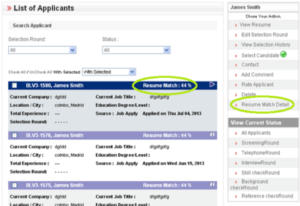
Applicant Tracking Software is flawed
Applicant Tracking System (ATS) programs have been with us for a while now. They were first introduced just before the turn of the century with names like BrassRing and RecruitMax. Being almost 20 years old you might think they were a mature technology that was sophisticated, predictable, and easy to understand. Unfortunately, as Paul Reiser would say, “Not so much.”
Here’s the problem as it exists now. All applicant tracking systems use the same word-parsing parameters, with only minor variations. Natural Language (NL) processing and Artificial Intelligence (AI) have both evolved tremendously in the last 20 years, but the parsers are still stumbling over themselves and each other.
Succeeding Where Others Fail
When you create a résumé, always use a traditional .txt, .doc, .docx or other conventional format. ATS software is notoriously bad at interpreting .pdf files. They cannot cope—they get confused—and your résumé will almost certainly be parsed incorrectly. At that point it will be rejected as being “unqualified” because it cannot pull out the facts it needs.
Millions of well-qualified candidates are rejected because they don’t conform to parsing expectations. So why do we keep using this system? First of all, it’s getting better, albeit slowly. Second, it takes a stack of résumés (potentially hundreds for each position) and turns it into the top 10 choices for a human being to look at.
Of course, they will lose great candidates. That is just the price they are willing to pay so that you don’t have to review so many documents. And despite the losses, they still get decent choices and a good place to start.
“There are no secrets to success. It is the result of preparation, hard work, and learning from failure” — Colin Powell
Keep in mind that parsing programs are still pretty dumb. Only include graphics or tables if you want your résumé to be rejected.
Here’s the problem: ATS software can’t assess pictures, and it reads tables from top-to-bottom, not left-to-right. The first column in your table might be a list of names, while the second might be a list of dates; what happens is that two facts which would be visually related when a human looks at it, fails to make any sense to the software. So just don’t do it.
Parsers Look at Things Differently
An original job description might look like the image below. The ATS software will go through it and select unique phrases (in red here) which differentiate it from all other positions being offered. Then a human may go in and add some specific terms that they desire.

Acronyms are Cool
Like the example above, if they are looking for a “Customer Service Representative” then use that term, but also include CSR because that may count towards your final score.
When ATS scans a résumé it will score the number of times you use these unique phrases from the original description. How many times have I seen a programming position advertised and then résumés come in laden with terms like “coder” or “code-wizard”, but not even once using just plain “programmer“?
“Error-prone applicant tracking systems kill 75 percent of job seekers’ chances of landing an interview as soon as they submit their résumés, despite how qualified they may be” – Meridith Levinson
You’re not “security conscious” or “threat-aware“; you’re PCI compliant, so say so. Whatever you see in the original offering, feed it right back to them. It’s not just a good idea—it’s the fundamental basis upon which the system operates.
Your goal is to get past these parsers, so you must follow their rules. One of the most important ones is to use the expected phraseology. Write “Work Experience“, not “Career Achievements” or “Professional Skills” because ATS Software will not recognize your creative terms. Use “Education“, “Skills“, and “Contact Information“. Your artistic choices may sound nicer, but it also means you won’t get hired.
Size isn’t Important
You hear it over and over again: Keep it brief. That would be an excellent idea that is both courteous and respectful of the reviewer’s time. But humans don’t see your résumé until well after they have decided to put your name on the interview list.

They have an excerpt that the ATS has collected and put into a database. What they will look at is similar to this image, where they can see how well you match the job description, and then elect to add you to the interview pool.
Other Stuff
Conformity is important. When you get around to writing down your Experience make sure it is always formatted Employer’s name, Job title, and then Dates of employment. If you start with a date the entire line will be ignored. That means a vital statistic, your experience, will not be included. And that will get your résumé kicked out of the system because you are “unqualified.”
The Takeaway
Properly constructed, your résumé should just fly through the system, landing right on top of the stack of interviewees. Take the time to learn to do it right to satisfy machines and please humans and you’ll have plenty of interviews.
Want to Know More?
We would love to hear from you. Click the link below if you would like to learn more.
Click To Speak With A Résumé Expert Today
Respected Résumés has 20 years’ experience in the field, producing more than 100,000 résumés. We have a 93% success rate in obtaining interviews, and that is precisely the sort of advantage you need on your side. Let’s get to work!
